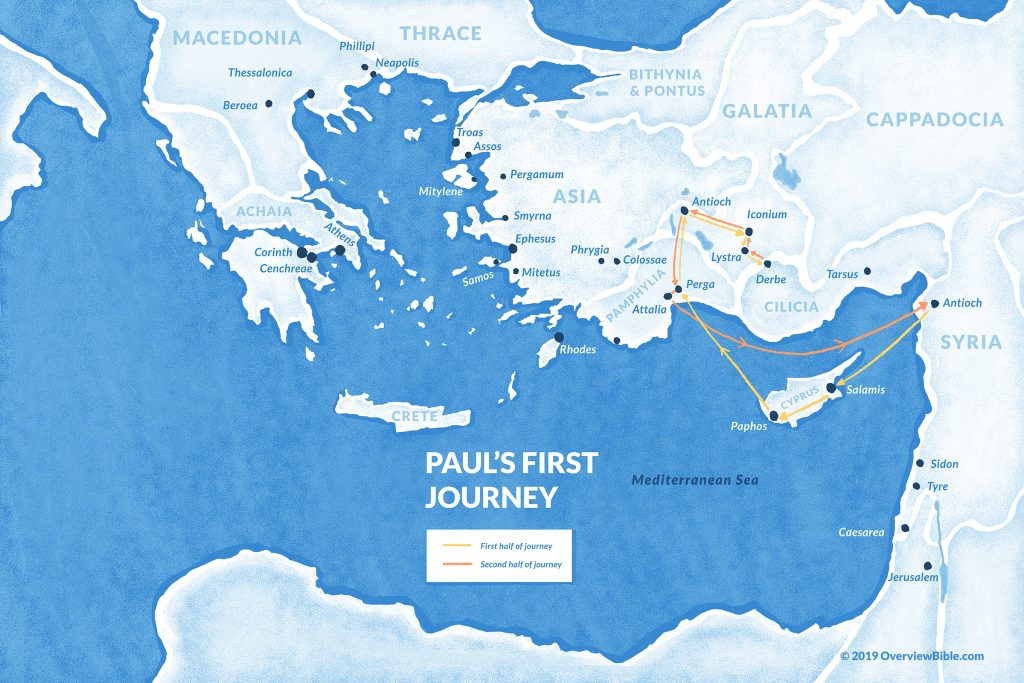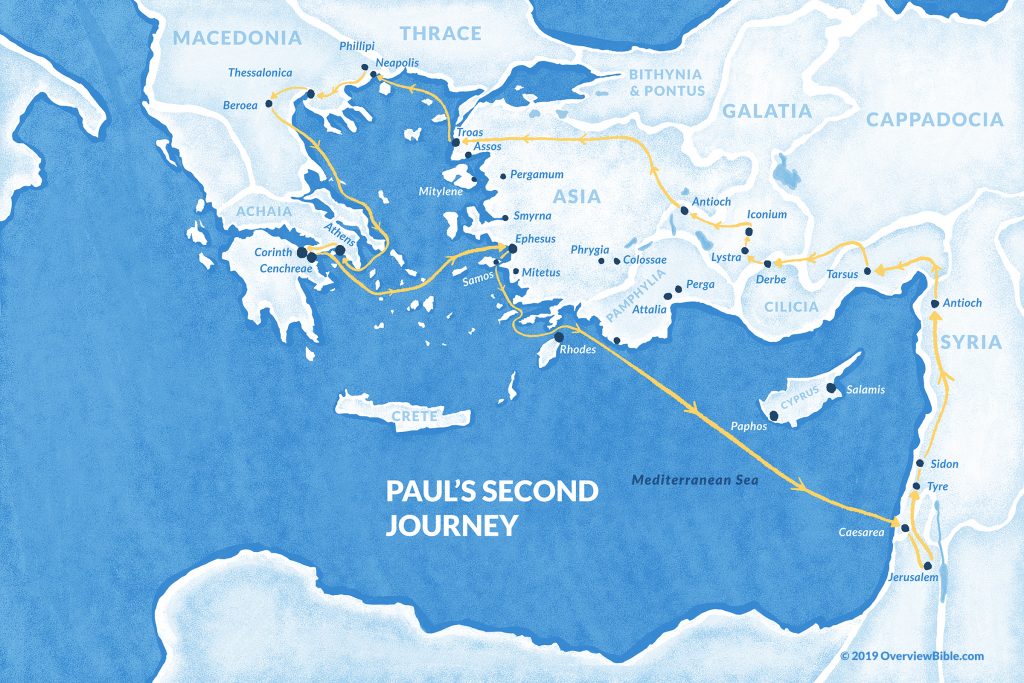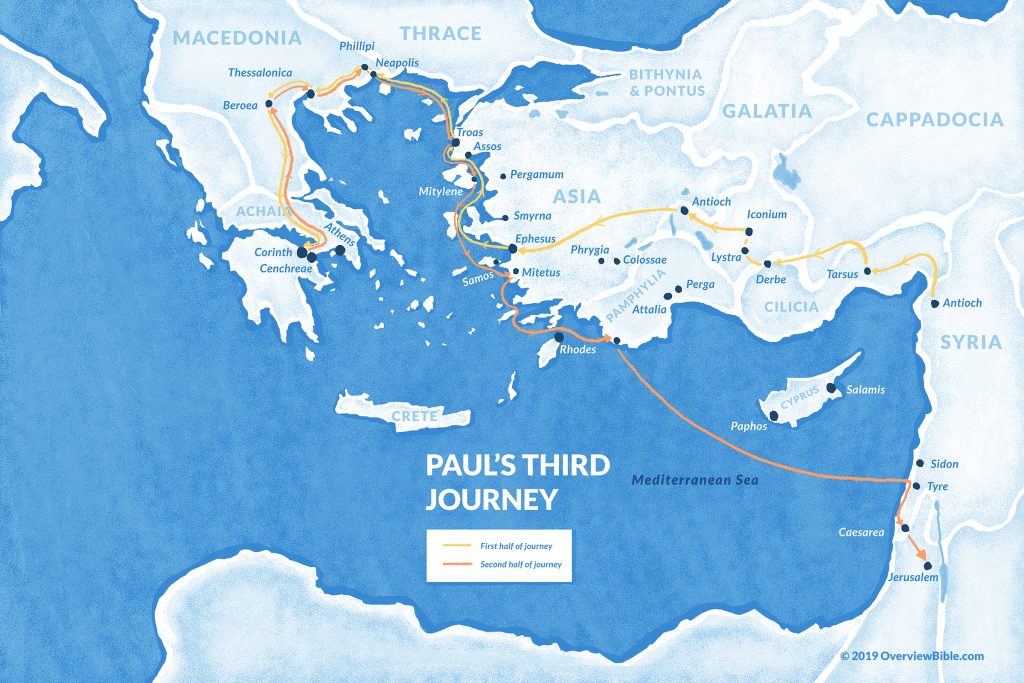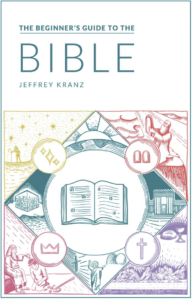Paul’s missionary journeys helped spread the gospel throughout much of the ancient world. Over the course of his ministry, the Apostle Paul traveled more than 10,000 miles and established at least 14 churches.
The Book of Acts records three separate missionary journeys that took Paul through Greece, Turkey, Syria, and numerous regions you won’t find on modern-day maps. Some scholars argue that Paul also took a fourth missionary journey, since parts of the New Testament appear to reference travels that may have taken place after the events in Acts.
Paul’s travels played a crucial role in the formation and development of the early Christian church. Many of the communities he encountered on these missionary journeys were the same ones he wrote to in his pastoral epistles.
In this guide, we’re going to follow Paul’s footsteps as he travelled across the ancient world, looking at the places he went and the major events that took place along the way. At times it can be challenging to distinguish between ancient cities, provinces, and regions (and there are sometimes multiple names that refer to the same area), so as we go, we’ll make some of those distinctions more clear.
Paul’s first missionary journey (Acts 13–14)
Paul’s first missionary journey began in Antioch. You may notice that maps of the ancient world often have two cities labelled Antioch. They’re both named after Antiochus, father of Seleucid I. The Antioch in Acts 13 was the third largest city in ancient Rome and capital of the province of Syria. Today, it’s part of southern Turkey. The other Antioch was part of Pisidia, an ancient region which is also now part of Turkey. Your Bible likely refers to it as Pisidian Antioch or Antioch of Pisidia.
In Antioch (the big city in Syria), the Holy Spirit singled out Paul and Barnabas from the believers worshiping there, and sent them on their first missionary journey.
Cyprus
Paul’s first journey took him by boat to the Roman province of Cyprus. Today, Cyprus is a country known as the Republic of Cyprus. It’s a mediterranean island south of Syria. Paul and Barnabas arrived in the port city of Salamis, where John Mark (who was possibly Barnabas’ cousin), helped them share the gospel in Jewish synagogues.
From Salamis, the group moved across the island to Paphos, where they were met by a Jewish sorcerer named Bar-Jesus (also known as Elymas the sorcerer). This sorcerer worked for the governor—Sergius Paulus—who sent for Paul and his companions because he wanted to hear the word of God. Elymas opposed them and tried to turn Sergius from the faith, and so Paul, filled with the Holy Spirit, called him a “child of the devil” and struck him blind. Sergius saw what happened, and believed.
Ironically, Elymas meant to steer Sergius away from Christ, but he became the very vehicle God used to draw Sergius toward him.
Pamphylia
From Paphos, Paul and company set sail for the Roman province of Pamphylia, located in modern day Turkey. They arrived in the city of Perga, where John Mark left them and returned to Jerusalem (which, interestingly, was in the opposite direction from where they just came). We don’t know why John Mark decided to leave, but this would later create a rift between Paul and Barnabas.
Together, Paul and Barnabas travelled to Pisidian Antioch, where local synagogue leaders invited them to speak. Initially, the Jewish people were receptive to the gospel, but a week later, the entire city gathered to hear Paul and Barnabas, and the Jewish leaders became jealous. They resisted the message of the gospel, and so Paul and Barnabas made an important pivot: they began preaching to the Gentiles.
Many of the Gentiles believed the gospel, and Luke (the traditional author of Acts) tells us that:
“The word of the Lord spread through the whole region. But the Jewish leaders incited the God-fearing women of high standing and the leading men of the city. They stirred up persecution against Paul and Barnabas, and expelled them from their region.” —Acts 13:49–50
Phrygia
Driven out of Pamphylia, Paul and Barnabas travelled to Iconium, an eastern city in the region of Phrygia. Iconium still exists today as the Turkish city of Konya.
Once again, Paul and Barnabas spoke in the synagogue, where Jews and Greeks alike accepted the gospel. But the Jews who didn’t accept it stirred up trouble, even as Paul and Barnabas began performing signs and wonders (Acts 14:3). As support for Paul and Barnabas grew, so did the opposition they faced, and eventually, they became aware of a plot to abuse and stone them. So they left.
Lycaonia
Fleeing the threat in Iconium, Paul and Barnabas left Phrygia altogether and travelled to Lystra, a city in the province of Lycaonia. Here, Paul healed a man who was lame.The locals who witnessed this miracle thought Paul and Barnabas were gods in human form, calling Barnabas Zeus and Paul Hermes. The priest from the temple of Zeus brought bulls and wreaths to offer sacrifices to them.
Paul and Barnabas attempted to redirect their praise to God, but struggled to keep the crowds from offering sacrifices to them.
Jews came from Antioch and Iconium and continued what they’d started. They riled up the crowds and convinced them to stone Paul. Believing he was dead, they dragged him outside the city. When the disciples gathered around him, Paul got up and went back inside the city.
Then Paul and Barnabas went to Derbe, another city in Lycaonia. There, they “won a large number of disciples” (Acts 14:21).
The return to Antioch
After a time in Derbes, Paul and Barnabas went back the way they came, working their way through Lystra, Iconium, Pisidian Antioch, and Perga. In each city, they encouraged the believers there and strengthened their faith, as they would continue doing on their future missionary journeys. They did, however, stop in a new Pamphylian city on the way: Attalia. Acts only mentions it in passing, but presumably, they established a community of believers there as well.
From there, they skipped a return voyage to the island of Cyprus and went straight back to Antioch (the big one), where they told the church what happened on their journey.
Paul’s second missionary journey (Acts 16:23–20:38)
Paul’s second missionary journey established many of the churches he would later write to in his pastoral epistles. Interestingly, this may have happened in part because of a “sharp disagreement” he had with Barnabas. Paul’s original plan was to essentially have a rerun of their first trip, strengthening the communities they’d formed in each city and telling them what the Council of Jerusalem had ruled in regards to Gentile believers.
But Barnabas wanted to take John Mark—who had left them shortly into their previous journey. Paul was so opposed to the idea that they parted ways, initiating two separate missionary journeys. Barnabas took John Mark and went with the original plan, making their way back to the island of Cyprus. Paul took a man named Silas and travelled through the provinces of Syria and Cilicia.
Lycaonia
The first cities that Acts mentions by name on Paul’s second journey are Derbe and Lystra. At this time, Paul and Silas picked up a new companion: Timothy.
The locals spoke highly of Timothy, and Paul wanted to bring him along even though he was half Greek, which meant local Jews would have a harder time accepting their message. Out of concern for these local Jews, Paul circumcised Timothy—even though, ironically, one of the things they were coming to tell Christians was that Gentiles didn’t have to be circumcised. (See Acts 16:3–4.)
Phrygia
Acts doesn’t specify where in Phrygia Paul and his companions stopped, but since he’d established a church in Iconium on the first trip, that community would’ve been on his mind (even though last time he was there, people had plotted to stone him). Interestingly, Acts notes that Paul and his companions journeyed here after they were “kept by the Holy Spirit from preaching the word in the province of Asia” (Acts 16:6).
Galatia
Just north of Phrygia was the province of Galatia. Acts makes no mention of what happened here, but this is the province Paul wrote to in his letter to the Galatians. Interestingly, part of the purpose of Paul’s second trip was to share the news from the Council of Jerusalem regarding the Law of Moses and whether or not Gentiles (or Christians in general) should be expected to follow it. The council decided the Torah didn’t apply to Gentile believers (though they did hang on to a few rules). But by the time Paul wrote the Book of Galatians, Christians there were feeling pressure to obey the law (particularly in regards to circumcision) in order to be saved.
Asia
From Galatia, Paul’s group traveled west, until they reached the border of Mysia—a western region in the province of Asia, which is now part of Turkey. They intended to head north to the region of Bithynia, “but the spirit of Jesus would not allow them to” (Acts 16:7). So they passed by Mysia and headed to the city of Troas. Here, Paul had a vision of a man in Macedonia, begging him to “Come over to Macedonia and help us.” Paul took this vision as a sign that God was calling them to Macedonia, which was across the Aegean Sea.
Macedonia
From Troas, Paul and his companions sailed across the Aegean Sea, making a pitstop on the island of Samothrace before landing in Neapolis and then traveling to Philippi. In Philippi, they spoke with women outside the city gate. One of them was a wealthy cloth dealer named Lydia. After her household was baptised, she persuaded Paul’s group to stay with her for a while.
Later, Paul, Silas, and the others were confronted by a spirit-possessed slave woman who could predict the future. She followed them for many days, shouting, “These men are servants of the Most High God, who are telling you the way to be saved” (Acts 16:17). Paul became so annoyed that he cast out the spirit. Her owners were furious, because they had been profiting off of her fortune telling. So they turned the local magistrates against them, claiming Paul and Silas were stirring up trouble and trying to get Roman citizens to believe and do illegal things.
The authorities had Paul and Silas severely flogged and thrown in prison. Late at night, while they were worshiping, an earthquake shook the foundations of the prison, opened the doors, and freed the prisoners from their chains. When the jailer awoke and saw the doors open, he prepared to kill himself. But Paul stopped him and assured him everyone was still in the prison.
After listening to Paul and Silas share the gospel, the jailer believed in Jesus and had his whole household baptized.
The next morning, the magistrates ordered Paul and Silas released. Paul revealed that they were Roman citizens, who had just been beaten and imprisoned without trial, and the authorities became afraid. Paul and Silas returned to Lydia’s house, and then left the city of Troas.
After passing through the Macedonian cities of Amphipolis and Apollonia, they arrived in Thessalonica. Since Thessalonica had a synagogue, Paul turned to his usual method—preaching the gospel on the Sabbath. Over the course of three weeks, he achieved the usual result—many Jews and Greeks alike embraced the gospel . . . and those who didn’t were outraged by it.
At night, the Thessalonian believers sent Paul and his companions away to the nearby city of Berea.
The Bereans listened eagerly to the gospel and carefully examined the Scriptures to see if they supported Paul’s claims. Many Jews and Greeks became believers, but some agitators from Thessalonica heard Paul was in Berea, and they stirred up the crowds. Silas and Timothy stayed in Berea, while Paul was escorted out of Macedonia to Athens.
Achaia
In the first century, Athens was in the region of Achaia, just south of Macedonia. Today, it’s the capital of Greece, and the largest city in the country.
Paul was essentially waiting around for Silas, Timothy, and the others to rejoin him. But while he waited, he noticed that Athens was full of idols. He debated with philosophers in both the synagogue and marketplace. Some Athenians were open to his ideas, and they were eager to discuss them. One idol in particular caught his eye—it had an inscription that read: “to an unknown god.” He seized on this as an opportunity to tell them about the “unknown God” who died and rose so that all might have eternal life.
Paul’s message in Athens incorporated observations about what he saw around him as well as quotes from famous Greek philosophers to point back to the gospel. After establishing a group of believers in Athens, Paul headed west to the city of Corinth.
In Corinth, Paul stayed and worked with a couple of Jewish tentmakers named Priscilla and Aquila. Every Sabbath, he preached to Jews and Greeks in the synagogue. Silas and Timothy rejoined Paul here, and Paul began focusing his energy on testifying about Jesus to the Jews.
When the Jews opposed his message, Paul devoted himself to reaching Gentiles, and he left the synagogue. As more Greeks embraced the gospel, the Corinthian Jews brought Paul before the governor, who basically told them to take a hike and refused to help.
Paul stayed in Corinth for a year and a half, and he left with Priscilla and Aquila.
The return journey
Before setting off for Syria, Paul stopped for a vow-fulfilling haircut in the port city of Cenchreae, which was just a hop, skip, and a jump from Corinth. With his companions, he sailed across the Aegean Sea to Ephesus, where he dropped of Priscilla and Aquila, and promised to come back if he could. After a short stay in Ephesus, Paul set sail for Caesarea, which was across the Mediterranean and far to the southeast. From there, he made the trek south to Jerusalem.
Paul’s second missionary journey ended in Jerusalem.
Paul’s third missionary journey (Acts 18:23–20:38)
When you read Acts, there’s no transition from Paul’s second missionary journey to his third. His arrival in Jerusalem almost immediately began his next trip. But while his second journey ends in Jerusalem, the beginning of his third journey is actually in Antioch, which is about 300 miles north.
Phrygia and Galatia
From Antioch, Paul once again worked his way west, passing “from place to place throughout the region of Galatia and Phrygia, strengthening all the disciples” (Acts 18:23). This included Derbe, Lystra, and Iconium.
Asia
Paul traveled west to Ephesus, the capital of the province of Asia, where he’d left Priscilla and Aquila on his previous journey. Since he’d last visited, a man named Apollos had been preaching part of the gospel, but he didn’t know about the Holy Spirit. So when Paul arrived, he taught the Ephesians about the difference between water baptism and the baptism of the Spirit.
For three months, Paul preached in the synagogues. When people started criticizing Christianity, he left and began holding discussions in a lecture hall.
This went on for two years, and all the while, God used Paul to perform miracles. Even things Paul had touched—handkerchiefs and aprons—healed the sick and drove out evil spirits.
Some Jews thought invoking Paul’s name would let them drive out demons. Seven sons of a chief priest named Sceva said to an evil spirit, “In the name of the Jesus whom Paul preaches, I command you to come out” (Acts 19:13). The spirit replied that it knew Jesus and Paul, but not them, and then it pulverized all seven of them.
As word spread about what happened, people began to revere the name of Jesus. Local sorcerors came to repent, and they burnt scrolls that would have been worth more than 130 years’ worth of wages (Acts 19:19).
Around this time, a local silversmith named Demetrius realized that the future of his business (making idols) was jeopardized by the gospel. The demand for idols was going down all across the province of Asia, but especially in Ephesus, where he lived. So Demetrius gathered all the craftsmen and workers whose businesses were impacted, and stirred the entire city into an uproar. They seized two of Paul’s companions and brought them into a theater.
Paul wanted to address the crowd, but the disciples didn’t let him. Instead, a city clerk told everyone that unless they were going to bring formal charges against the men in a legal assembly, they were in danger of being charged with rioting.
Macedonia and Greece
After things settled down in Ephesus, Paul headed across the Aegean Sea to Macedonia. He traveled throughout the region, encouraging believers, and eventually arrived in Greece, where he stayed for three months. He intended to sail back to Syria (where his journey started), but some people plotted against him, so he took another lap through Macedonia instead.
Along the way, disciples joined Paul from many of the communities he’d ministered to. He had companions from Berea, Thessalonica, Derbe, and the province of Asia. These followers went ahead of Paul to Troas, in Asia. Paul stayed briefly in Philippi, then joined them.
Asia
Paul stayed in Troas for seven days. The night before he left, he stayed up late talking in a room upstairs. A young man sat in a window, drifted off to sleep, and fell to his death. Paul threw his arms around the man and declared that he was alive, and he was. Then Paul went back upstairs and continued talking until daylight.
Paul walked from Troas to Assos, which was just to the south, and then sailed for the nearby city of Mitylene. Eager to reach Jerusalem before Pentecost, Paul sailed past Ephesus and stopped in Miletus. There, he met with the leaders of the Ephesian church and essentially told them that he had taught them everything they needed to know, that he would not see them again, and that they needed to be on guard against false teachers. This is when Paul also famously quoted Jesus, sharing words that aren’t recorded in any of the gospels: “It is more blessed to give than to receive” (Acts 20:35).
And then he set sail.
The return journey
Paul and his companions stopped briefly in Kos, Rhodes, and Patara before heading across the Mediterranean Sea to Phoenicia (the coastal region south of ancient Syria, which is now part of Syria). They arrived in Tyre, where “through the Spirit” (Acts 21:4), the local disciples urged Paul not to go to Jerusalem. He ignored them.
From Tyre, the voyage continued to the port city of Ptolemais, and then Caesarea, where the group stayed with Philip the evangelist (not to be confused with Philip the apostle). Here, a prophet warned Paul that he would be bound by the Jews in Jerusalem and handed over to the Gentiles.
Still, he pressed on to Jerusalem, and by the end of Acts, the Jewish leaders had handed him over to Roman rulers.
Paul’s fourth missionary journey
Acts explicitly records three distinct missionary journeys. But some scholars and even ancient Christian writers have claimed that there was also a fourth missionary journey which was only hinted at in the Bible.
The argument for a fourth journey is primarily based on clues from Paul’s letters. He occasionally refers to events and visits that may not be accounted for in Acts or the epistles.
For example, Paul suggested he would travel to Spain (Romans 15:24), but he provides no record of this journey in his letters. However, early church fathers claimed Paul did, in fact, travel to Spain.
In his letter to the Corinthians, first-century church father Clement of Rome said Paul “had gone to the extremity of the west,” which at the time presumably meant Spain. Fourth-century church father John of Chrysostom said, “For after he had been in Rome, he returned to Spain, but whether he came thence again into these parts, we know not.” And Cyril of Jerusalem (also from the fourth century) wrote that Paul “carried the earnestness of his preaching as far as Spain.”
In 2 Timothy 4, Paul makes an ambiguous reference to “my first defense” and claims he was “delivered from the lion’s mouth” (2 Timothy 4:16-17). Some have interpreted this as a reference to his first defense before Emperor Nero, which he was heading for at the end of Acts.
Paul’s letters make other references to events not recorded in Acts, but since there is so much overlap in the locations mentioned, and Paul spent multiple years in some of these places on his three recorded journeys, it’s difficult to say whether or not this fourth journey ever actually happened.
Take a closer look at Paul’s footsteps
Paul’s missionary journeys are a key part of the New Testament. Paul’s epistles were originally written to the communities he formed on these journeys, and they show us exactly how Christianity spread to the Gentiles so rapidly.
Here at OverviewBible, we’ve charted each of Paul’s missionary journeys into beautiful, full-color posters you can display in your classroom or church office. Each comes in multiple sizes on fine art paper with a matte finish.
Get an overview of the entire Bible
The Bible is huge. Together, its 66 books are three times longer than Moby Dick. It’s so big that even if you’ve been reading it your whole life, you can still miss the point. Jeffrey Kranz, founder of OverviewBible, wrote The Beginner’s Guide to the Bible to help Christians and non-Christians alike get a better grasp of this important text.
This non-preachy, jargon-free guide will walk you through the Bible’s major themes and characters and help you see how each book fits into the larger story of Scripture.










